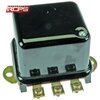I’m looking for a voltage regulator for an American-built tractor. Problem is, it’s for a dynamo where the field winding is commoned with the dynamo output (D terminal) inside the dynamo, and the trembling regulator contacts are on the earth side. I believe that’s called a Type A regulator. (Much more common in UK, the field is earthed in the dynamo and fed with voltage from the regulator. Presumably that is Type B. That type is readily available 2nd hand)
Dynamo and original regulator are 12-volt AC-Delco. Anybody know where I can get one? Or what vehicles in UK used AC-Delco electrics? I believe earlier Vauxhalls is one.
I got one from USA via Amazon and it is useless. If connected it would cause a short circuit, and the voltage coil in the cut-out bobbin is not connected! Probably Chinese-made. Sent it back and waiting for a refund. Very crude sketch attached.
Any help appreciated.
Dynamo and original regulator are 12-volt AC-Delco. Anybody know where I can get one? Or what vehicles in UK used AC-Delco electrics? I believe earlier Vauxhalls is one.
I got one from USA via Amazon and it is useless. If connected it would cause a short circuit, and the voltage coil in the cut-out bobbin is not connected! Probably Chinese-made. Sent it back and waiting for a refund. Very crude sketch attached.
Any help appreciated.



